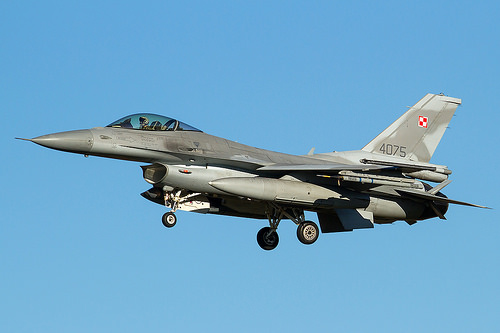Exercise Watch: NATO-Atomwaffenübung Steadfast Noon – erstmals mit Polen (Update)
Die NATO-Übungsserie Steadfast Noon findet seit Jahren regelmäßig statt – und ebenso regelmäßig üben dabei Luftwaffen mehrerer NATO-Staaten, darunter auch Deutschland (Foto oben), den Einsatz von Atomwaffen. Die meisten beteiligten Länder haben zwar kein eigenes Nuklear-Arsenal, aber ihre Kampfjets sind im Kriegsfall dafür vorgesehen, US-Atombomben ins Ziel zu bringen.
Neu bei der diesjährigen Übung Steadfast Noon 2014, die in Italien stattfindet, ist offensichtlich eines: Erstmals sind polnische F-16-Jagdbomber dabei. Darauf weist die Federation of American Scientist (FAS) am (heutigen) Montag in einem Beitrag hin:
The exercise, known as Steadfast Noon 2014, practices employment of U.S. nuclear bombs deployed in Europe and includes aircraft from seven NATO countries: Belgium, Germany, the Netherlands, Poland, Turkey, and United States.
The timing of the exercise, which is held at the Ghedi Torre Air base in northern Italy, coincides with East-West relations having reached the lowest level in two decades and in danger of deteriorating further.
It is believed to be the first time that Poland has participated with F-16s in a NATO nuclear strike exercise.(…)
The participation of Polish F-16s in a NATO nuclear strike exercise is noteworthy because Polish F-16s are not thought to be capable of delivery nuclear weapons or assigned nuclear strike missions under NATO or U.S. nuclear planning.
The two Polish F-16s that have been photographed at Ghedi Torre Air Base are from the 10th Tactical Squadron (ELT) of the 32nd Wing (BL) at Lask Air Base in western Poland. (Another source reported three Polish F-16s).
If Polish F-16s were directly involved in NATO nuclear strike planning, it would be a significant new development.
Update: Wie in einigen Kommentaren schon angemerkt und wie mir auch von fachkundiger Seite aus einem anderen NATO-Mitgliedsland mitgeteilt wurde: Eine polnische Beteiligung an dieser Übung bedeutet nicht, dass Polen nunmehr in die so genannte nukleare Teilhabe eingebunden wäre oder dass die Allianz damit die Abkehr von der NATO-Russland-Grundakte vorbereitet.
Schon immer, so habe ich inzwischen gelernt, waren alle NATO-Nationen zur Beteiligung an der Übung eingeladen, zum Beispiel für die genannte taktische Absicherung der eigentlichen Bomber; bisher hatten sich aber Nationen außerhalb des eigentlichen Atomwaffen-Kreises nicht beteiligt. Darüber hinaus sind weder polnische Basen noch Flugzeuge noch Piloten für den Einsatz von Nuklearwaffen zertifiziert.
Dennoch ist die erstmalige polnische Beteiligung an diesem Manöver ein interessantes Signal, von wem auch immer es ausging und wie man es bewertet. Die Bewertung der FAS ist deshalb durchaus sinnig:
Although the Steadfast Noon-STRIKEVAL nuclear exercise has been planned for a couple of years, the timing is delicate, to say the least, because of deteriorating East-West relations following Russia’s invasion of Ukraine earlier this year. Russian and NATO exercises have combined to fuel a perception of a crisis that goes well beyond words to increased military posturing on both sides, reminiscent of mindsets we haven’t seen in Europe since the 1980s.
Under these conditions, there is a real risk that the tactical nuclear strike exercise at Ghedi AB with participation of Polish F-16s could feed into Russian paranoia about NATO’s military intensions. A comparable operation would be if Russia were to conduct nuclear air-strike exercises to reassure Belarus. That would deepen paranoia in eastern NATO countries and could give tactical nuclear forces in Europe a prominence that is not in anyone’s interest.
(Foto oben: Tornado der Luftwaffe bei Steadfast Noon, unten: polnische F-16 bei Steadfast Noon – Fotos mit freundlicher Genehmigung von Fabrizio Berni, PITI Spotter Club, Italien)





Tja, wer konventionell bis zur völligen Wehrlosigkeit abrüstet muss eben nuklear überkompensieren.
Genau mit diesem Axiom hat sich seit Adenauer so ziemlich jede Nato Struktur Debatte mit Hinblick auf Deutschland beschäftigt.
„Nur Munition für eine Woche Schießkrieg“,
„Divisionen die Frontabschnitte von 100 Kilometern abdecken sollen“
„“Keine Reserven“
usw. usw.
das dürfte sich heute alles noch um den Faktor 10 potenzieren lassen.
(auch lustig das man sich sorgen um russische „paranoia“ macht die man angeblich durch manöver fördert wärend Russland munter erstschlagsträgermittel in königsberg stationiert und unter bruch des irbm vertrages nuklearwaffenfähige marschflugkörper entwickelt.)
bevor die frage kommt:
zweiter Beitrag des SuS Podcasts
„INF-Vertrag vor dem Aus?“
http://www.ndr.de/info/Streitkraefte-und-Strategien,audio216766.html
Eine Blöde Diskussion für Deutschland
Weil Deutschland hat die Scheuklappen auf ,Patriot Einheiten werden aufgelöst
Wohl wir mehr bräuchten
Hunde die bellen beißen nicht das weiß Herr Putin
wir wollen jetzt schon nicht s mehr wissen weil wie erwartet ( weil der Export wegfällt )
Fangen unser Manager an zu flennen statt zu Handeln
und eine Regierung was Beschliessen wird für die Autoindustrie wohl die BW einigen Kaufen würde
@TW
Ankündigung nächste Großübung in Litauen. Iron Sword 2014
http://en.delfi.lt/lithuania/defence/german-military-equipment-to-be-brought-to-lithuania.d?id=66213856
http://kariuomene.kam.lt/en/military_insignia/news_1889/lithuanian_and_allied_forces_are_getting_ready_for_international_exercise_iron_sword_2014.html
Die erste Übung an der Ostflanke mit signifikanter Beteiligung Deutschlands.
pi
Schöne Bilder von der Übung / Dem Beitragt fehlt ja noch eins ;)
http://www.pitispotterclub.it/foto-manifestazioni-airshow-e-trasferte/2014/2014-steadfast-noon-2014-ghedi/
http://piti.forumfree.it/?t=69715917
Eine polnische Beteiligung an Steadfast Noon impliziert nicht notwendigerweise, dass die Zusagen an Russland aus der NATO-RUSSLAND-Aktie angetastet oder verletzt werden. Die NATO offeriert ihren Mitgliedern seit vielen Jahren auch die Möglichkeit, sich in nicht.-nuklearer Mission an der nuklearen Teilhabe zu beteiligen, damit eine größere Zahl an Ländern in dieses Konzept eingebunden werden können und dieses nach außen hin von mehr Ländern mitgetragen wird. Zu den nicht-nuklearen Aufgaben gehören dann z.B. der Begleitschutz durch Jagdflugzeuge oder die Bereitstellung von Luftbetankung.
Russland hat man lediglich zugesagt, dass auf dem Gelände der neuen NATO-Mitglieder keine nuklearen Waffen stationiert werden, keine nuklearen Lagermöglichkeiten geschaffen oder alte genutzt werden, sowie seitens der US-Regierung erklärt, dass es nicht für notwendig gehalten wird, Piloten aus diesen Ländern für nukleare Missionen auszubilden oder Programs of Cooperation zu vereinbaren. Trotzdem ist die von FAS angemerkte Signalwirkung natürlich gegeben.
@wacaff
Der S+S-Beitrag beruht auf US-Angaben, die meines Wissens nicht ausreichend durch Aufklärungsergebnisse gedeckt sind und auch nicht von allen Analytikern der US-Regierung geteilt werden. Die vermutete Stationierung eines landgestützten Marschflugkörpers mit Nuklearsprengkopf und Reichweitevon mehr als 500km zum Verschuss mit dem Raketenwerfer Iskander kann nicht als gesichert belegt gelten.
Sie wird nur für möglich gehalten. Zum Beleg angeführte Photos aus dem Sommer lassen auch an andere Interpretationen zu.
@ ona
zum thema iskander:
mag sein das die technischen details nicht zu 100 % verifiziert sind. die mehrrollenfähigkeit von iskander-k ist aber zumindest plausibler als das gegenteil.
abgesehen davon ist ja auch „nuclear ambiguity“ teil der nuklearstrategie. wer so agiert hat imho das recht auf „paranoia“ bei routinemanövern des „wettbewerbers“ verwirkt.
Wenn man sich den Artikel mit etwas Distanz durchliest, dann werden da aus sehr wenig Indizien sehr große Rückschlüsse gezogen. Dem kann man folgen, muss man aber nicht.
Wenn man sich etwas über die Gehimhaltungsbestimmungen Gedanken macht, ist es extrem unwahrscheinlich, dass hier irgendwelche Informationen über nukleare operationen geflossen sind.
Wenn die Polen tatsächlich an der Übung teilgenommen haben, dann wohl eher im Sinne von SNOWCAT (support of nuclear operations with conventional air tactics). Bei google finden sich unter „nato snowcat“ einige documente die diese Idee näher beleuchten.
Über das timing darf man sich dann immernoch trefflich streiten.
Der Weltuntergang wird nur mittelbar durch Viren und Kernwaffen kommen. Ursächlich wird die Verbreitung serifenloser Schriftarten sein. „Gehirnhaltungsbestimmungen“. Eine völlig neue Klasse von kombinierten Tipp-Lese-Fehlern öffnet den Schlund der Hölle.
SCNR
@ califax
cerebrale kernschmelze? ;-)
Sorry, da habe ich nach dem korrigieren wieder die alte Version einkopiert.
Die “Gehirnhaltungsbestimmungen“ gefallen mir aber! Wenn es da kein Copyright gibt werde ich das schamlos weiterbenutzen.:-)
Mit Blick auf die verschiedenen NATO-Übungen ist folgende Analyse hoffentlich interessant:
http://www.jamestown.org/single/?tx_ttnews%5Btt_news%5D=42966&no_cache=1#.VE66zfmG_gc
Kernthese:
Bis die NATO sich auf die Ereignisse von 2014 eingestellt hat ist 2016.
Dann ist man halbwegs auf die Szenare von 2014 vorbereitet.
Aber die Russen haben sich bis dahin nochmals erheblich weiterentwickelt.
Durchaus plausibel.
@all
Habe oben mal ein update reingeschrieben; auch mit dem, was hier in den Kommentaren aufkam.
@axel_f
Die Fotos hatte ich schon gesehen, brauchte aber erst die Genehmigung des Fotografen, sie auch zu verwenden. Die habe ich inzwischen, deshalb oben die Bilder nachgetragen.
@ memoria
vielleicht sind wir dann ja unfreiwillig innovativ weil wir uns intellektuell nie aus den 70ern wegbewegt haben.
alles zyklisch wie in der mode.
dude! your strategy is so vintage, totally hot in moscow too atm. ;-)
In der Jamestown Analyse wurde wieder das Westlich Politisch Korrekte Ergebnis vorgegeben. Daraufhin wurde eine Seichte Geschichte Konstruiert, die sehr weit von der Realität dort entfernt ist. Das fängt schon an, dass die Ukraine quasi ein geteiltes Land ist. Die Ostukraine ist stark Pro Russisch, der Rest stark Pro Westlich. Das ganze ist da für die Russen quasi ein Heimspiel. Dort haben auch immer Oligarchen die Macht gehabt, und die haben dafür gesorgt, dass die Identität mit dem Staat Ukraine zumindest in Neurussland sehr gering ist. Nachdem Yanu geflohen ist, haben sich extrem Russisch Feindliche Kräfte an die Macht gesetzt. Die hatten keinen Plan, waren Handlungsunfähig und haben die Pro Russische Bevölkerung gg. sich aufgebracht. Das haben die Russen ausgenutzt und sind auf die Krim aufmarschiert. In Masse ist die ganze Krim Bevölkerung zu den Russen übergelaufen. Da hatten die Ukrainer keine Chance. Wegen der Schwarzmeerflotte konnten die auch keine Verteidigung gg. die Russen aufbauen. Danach wollte sich der Donbass von der Ukraine abspalten. Kiew wollte das Verhindern und hat eskaliert bis zum Bürgerkrieg, wo dann Russland wegen den engen Gesellschaftlichen Beziehungen zu den Donbass eingestiegen ist.
Der Unterschied im Donbass ist halt, die Separatisten werden von Russischen Profis geführt und die Ukrainer von Chaoten. Putin hat den Krieg gewonnen, der noch lange nicht zu Ende ist. Am Ende wird Russland komplett Neurussland von der Ukraine abspalten. Militärisch kann Kiew da nichts machen, und Politisch sind die in ihren Russland Hass gefangen.
Die Seps Bearbeiten wohl vor allem die Nordöstliche Front, die nur von Freiwilligen gehalten wird. Da wird ganz klassisch vorgegangen. Zuerst wird aufgeklärt, dann werden die Stellungen und gepanzerten Fahrzeuge mit Ari zerstört und dann mit Fußtruppen wird der Rest gesichert. Wenn die Front aufgerieben ist, und der Weg nach Kharkiv frei ist, werden dort auch wieder alle zu den Russen überlaufen. Der Rest passt sich halt den Gegebenheiten an.
Vielleicht gibt es dann Gespräche auf höchste Ebene zwischen den Pintschuk Oligarchen und Putin. Und nicht mehr mit Selbstdarstellern wie Jaz oder Poro.
@ Benedict
Und es trollt wieder so schön. Warum wohl haben die Separatisten die Bevölkerung in der Ostukraine am letzten Wochenende am Wählen gehindert?
Ehrlich gesagt, bis auf die coolen Politikerabkürzungen klingen Ihre Beiträge wie das „Neue Deutschland“ vor 1990.
Wer hat eigentlich die Abwurfcrew „little boy“ zertifiziert und wie darf man sich das heute vorstellen? Praktikum als Röntgenassi in einem BW Krankenhaus oder reicht Leistungskurs Physik?
@califax
Ihren „Schlund der Hölle“ sollten Sie bei anderen Netzwerken posten – garantiert Milliarden Klicks und Beiträge – zwar nur von „Verschwörungstheoretikern“- aber wass solls.
Sehr schöner Beitrag- Danke.
Was war noch mal serifenlos( klingt französisch und bedeutet ohne Füsse?,
das passt ja auf DEU SiPo)
@wacaffe
Niemand stellt infrage, dass Iskander als dual capable angenommen werden muss; auf die psychologische Komponente weißt auch FAS richtigerweise hin – Sie haben aber offenbar mein Argument nicht verstanden – all das wäre keine Verletzung des INF-Vertrags.
Die gäbe es nur, wenn nachweislich mit Iskander ein (getesteter) landgestützter Marschlugkörper (nicht ballistischer FK) stationiert worden wäre, der eine Reichweite größer 500km hätte – und dafür fehlts am Beleg im Blick auf die These: RUS verletzt INF-Vertrag.
Sorry für die verspätete Reaktion – leide unter Überbeschäftigung und kann nur punktuell reinschauen.